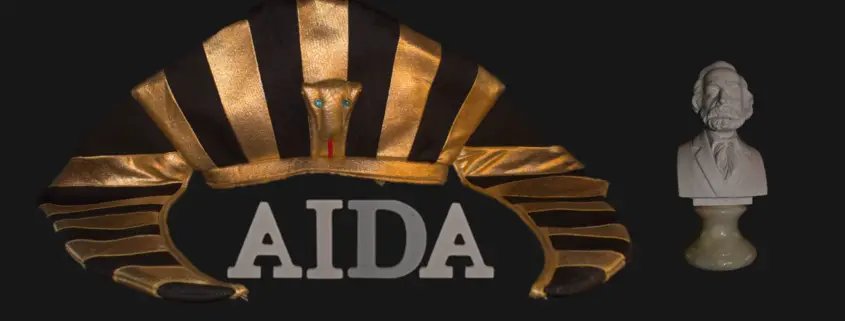The online opera guide of Verdi’s Aria CELESTE AIDA
Read Interesting facts and hear great YouTube Videos about the famous Aria “Celeste Aida” from Giuseppe Verdi
If you want to hear more about the opera Aida, click on the
The Aria – Synopsis and background
Synopsis: Aida, the daughter of the Ethiopian king Amonasro is a slave at the Egyptian court. The Ethiopian warriors attack Egypt to free Aida. Radames dreams of returning to his secret love Aida wreathed in laurel.
Verdi offers considerable difficulties to the role of Radames. The role is “lirico spinto”, i.e. a youthful heroic tenor. Radames must be able to sing both the great heroic arias and the lyrical piano passages. Right at the beginning, poor Radames must sing the great aria “Celeste Aida”, without warm up. Some tenors regard Celeste Aida as Verdi’s most difficult tenor aria.
The tenor voice must be able to withstand sharp trumpet sounds and keep up with the warmth of the woodwinds. He must also be confident in the high notes. The aria, another difficulty, starts unaccompanied by the orchestra. The aria alternates several times between the poles of battle (“un esercito di prodi, da me guidato”) and love (“Celeste Aida”). The love passages must be sung with much legato and sometimes in beautiful pianissimo.
Celeste Aida – the text
Se quel guerriero io fossi
Se il mio sogno si avverasse!…
Un esercito di prodi da me guidato…
E la vittoria
E il plauso di Menfi tutta!
E a te, mia dolce Aida,
Tornar di lauri cinto…
Dirti, per te ho pugnato,
E per te ho vinto!Celeste Aida, forma divina,
Mistico serto di luce fior,
Del mio pensiero tu sei regina,
Tu di mia vita sei lo splendor.
Il tuo bel cielo vorrei ridarti,
Le dolci brezze del patrio suol,
Un regal serto sul crin posarti,
Ergerti un trono vicino al sol.Celeste Aida, forma divina,
Mistico raggio di luce fior,
Del mio pensiero tu sei regina,
Tu di mia vita sei lo splendor.
Il tuo bel cielo vorrei ridarti,
Le dolci brezze del patrio suol,
Un regal serto sul crin posarti,
Ergerti un trono vicino al sol.
If I were
that warrior! If my dreams
were to come true! A valiant army
led by me… and victory… and the acclamations
of all Memphis! And to return to you, my sweet Aida,
crowned with laurels…
to tell you: for you I fought, for you I conquered!Heavenly Aida, form divine,
mystical garland of light and flowers,
of my thoughts you are the queen,
you are the light of my life.I would return to you your lovely sky,
the gentle breezes of your native land;
a royal crown on your brow I would set,
build you a throne next to the sun.
Written for a Spinto Tenor
The role of Radames is written for a spinto tenor (Italian) respectively young heroic tenor (German). The voice is strong and masculine. It has a metallic brilliance in the high notes. It captivates with its effortless power in the higher tessitura and has still agility. In the high register the Spinto Tenor can inspire the audience with top notes.
Famous interpretations of the Aria “Celeste Aida”
Listen to Jussi Björling and Placido Domingo two excellent interpreters of this role.
Se quel guerriero io fossi…Celeste Aida (1) – Björling
Se quel guerriero io fossi…Celeste Aida (2) – Domingo
Richard Tucker
The next interpretation is by Richard Tucker, perhaps the greatest American opera singer of the 20th century. He was born in New York as Reuben Ticker and began his vocal training as Chazzan (cantor). His breakthrough “came with the legendary performance of Aida, which was conducted by Arturo Toscanini, was recorded and became a legend. It was the first television opera to be broadcast worldwide (concertante)… This recording became famous with the finale of the Radames aria “Celeste Aida”. Toscanini insisted that the high Bb would be sung piano at the end, as Verdi, in his opinion, had planned. Tucker had difficulty with this, and Toscanini introduced a compromise solution: he let the tenor sing the B forte, then go down an octave and repeat the middle B in the piano.” (Fischer, grosse Stimmen)
Se quel guerriero io fossi…Celeste Aida (3) – Tucker
Bergonzi and the high B
Finally a fourth recording of Celeste Aida. Bergonzi was not only an excellent tenor (Radames was one of his parade roles), but also an excellent musician. So it was a matter of course for him to sing a B in the piano at the end, which was not always to the taste of the audience. So he had to “experience in the Teatro Regio in Parma that the audience protested when he sang the final B of Celeste Aida in this difficult piano passage. He never entered this opera house again.” (Fischer, big voices)
Celeste Aida (4) – Bergonzi
Luciano Pavarotti
Celeste Aida (5) – Pavarotti
Peter Lutz, opera-inside, the online opera guide to CELESTE AIDA from the opera Aida




Great Guide. Good choice of interprets.